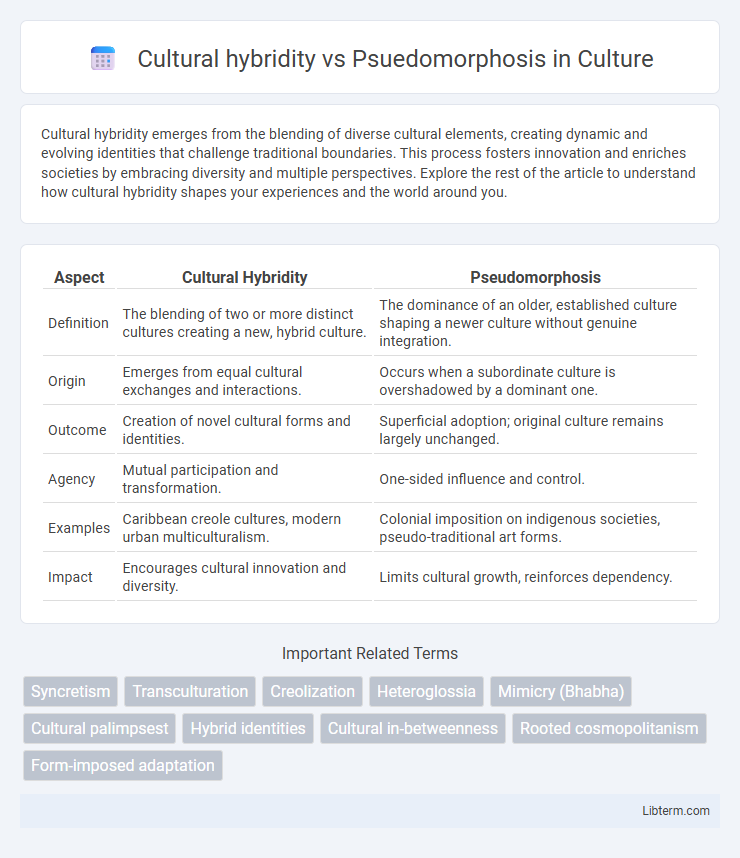Cultural hybridity emerges from the blending of diverse cultural elements, creating dynamic and evolving identities that challenge traditional boundaries. This process fosters innovation and enriches societies by embracing diversity and multiple perspectives. Explore the rest of the article to understand how cultural hybridity shapes your experiences and the world around you.
Table of Comparison
| Aspect | Cultural Hybridity | Pseudomorphosis |
|---|---|---|
| Definition | The blending of two or more distinct cultures creating a new, hybrid culture. | The dominance of an older, established culture shaping a newer culture without genuine integration. |
| Origin | Emerges from equal cultural exchanges and interactions. | Occurs when a subordinate culture is overshadowed by a dominant one. |
| Outcome | Creation of novel cultural forms and identities. | Superficial adoption; original culture remains largely unchanged. |
| Agency | Mutual participation and transformation. | One-sided influence and control. |
| Examples | Caribbean creole cultures, modern urban multiculturalism. | Colonial imposition on indigenous societies, pseudo-traditional art forms. |
| Impact | Encourages cultural innovation and diversity. | Limits cultural growth, reinforces dependency. |
Defining Cultural Hybridity: Concepts and Origins
Cultural hybridity refers to the process where two or more distinct cultural identities merge to create a new, syncretic culture characterized by dynamic interactions and mutual influences. Originating from postcolonial theory and anthropology, this concept highlights how colonized societies resist and transform imposed cultural forms by blending indigenous and foreign elements. Unlike pseudomorphosis, which denotes the imposition of a dominant culture's framework on a subordinate one, cultural hybridity emphasizes reciprocal shaping and creative cultural synthesis.
Pseudomorphosis: Unraveling the Meaning
Pseudomorphosis refers to the phenomenon where a dominant culture imposes its values and structures on a subordinate one, leading to a distorted or incomplete cultural development in the latter. This concept highlights the imbalance of cultural power, where indigenous traditions are overshadowed or assimilated by foreign influences without authentic integration. Unlike cultural hybridity, which results in a creative fusion of cultures, pseudomorphosis signifies cultural stagnation or misrepresentation caused by external domination.
Historical Contexts: How Hybridity and Pseudomorphosis Emerge
Cultural hybridity emerges from historical processes of colonization, migration, and globalization, resulting in the blending of indigenous and foreign cultural elements into new, dynamic identities. Pseudomorphosis occurs when a dominant external culture imposes itself onto a subordinate culture, often stunting the latter's organic cultural development and preserving older forms under a veneer of imposed traits. Both concepts highlight the complexities of cultural interaction but differ in the agency and authenticity of cultural transformation through historical power dynamics.
Key Differences Between Hybridity and Pseudomorphosis
Cultural hybridity refers to the process where two or more distinct cultures interact and blend, creating a new, integrated cultural form characterized by mutual influence and adaptation. Pseudomorphosis, in contrast, occurs when one dominant culture imposes itself on another, causing the subordinate culture to adopt external elements without genuine integration, often leading to cultural distortion or resistance. The key difference lies in hybridity's reciprocal exchange fostering innovation and diversity, whereas pseudomorphosis results in asymmetry and cultural domination without true synthesis.
Case Studies: Real-World Examples of Cultural Hybridity
Cultural hybridity manifests in case studies such as the fusion of indigenous African art forms with contemporary Western influences, creating unique postcolonial identities that challenge traditional cultural boundaries. The mestizo culture of Latin America exemplifies hybridity through the blending of Native American and Spanish colonial elements in language, religion, and social customs. These real-world examples highlight dynamic cultural exchanges rather than static impositions, contrasting with pseudomorphosis where one culture's form dominates and deforms another's organic development.
Case Studies: Instances of Pseudomorphosis in Societies
Instances of pseudomorphosis in societies reveal patterns where dominant cultures impose their structures on indigenous systems, creating superficial adaptations without genuine integration or transformation. Case studies include colonial India, where British governance overlaid traditional social orders, and Japan's Meiji era, which initially mimicked Western models before evolving unique modern institutions. These examples illustrate how pseudomorphosis hinders organic cultural hybridity by enforcing external frameworks rather than fostering mutual synthesis.
Influences on Identity Formation: Hybridity vs. Pseudomorphosis
Cultural hybridity influences identity formation by blending elements from multiple cultures, creating dynamic and fluid self-conceptions that resist singular cultural narratives. In contrast, pseudomorphosis occurs when a dominant culture imposes its framework onto a subordinate one, stifling authentic identity development and preserving colonial or hegemonic power structures. Hybridity promotes intercultural dialogue and innovation, whereas pseudomorphosis enforces cultural dependency and limits individual or collective agency.
Impact on Art, Language, and Expression
Cultural hybridity fosters the blending of diverse artistic styles, languages, and expressions, creating innovative forms that reflect multiple heritages and promote cross-cultural dialogue. Pseudomorphosis, by contrast, occurs when a dominant culture imposes its forms on a subordinate one, often resulting in a distortion or suppression of native artistic and linguistic traditions. The impact on art and language in hybridity leads to dynamic syncretism and evolving identities, while pseudomorphosis tends to cause cultural stagnation and loss of authentic expression.
Social and Political Implications: Integration vs. Imitation
Cultural hybridity fosters social integration by blending diverse traditions and enabling political inclusivity, promoting innovative identities and adaptive governance structures. Pseudomorphosis, by contrast, perpetuates imitation of dominant cultures, often resulting in social alienation and political dependency that stifle indigenous agency and authentic development. The tension between these concepts influences power dynamics, identity formation, and the legitimacy of political authority within postcolonial and globalized societies.
Future Trends: The Evolving Landscape of Cultural Interaction
Cultural hybridity exemplifies the dynamic blending of diverse traditions, fostering innovation and new cultural expressions that reflect global interconnectedness. Pseudomorphosis, in contrast, often involves the imposition of one culture's forms onto another, risking stagnation and superficial adaptation. Future trends indicate a growing preference for genuine hybridization, driven by digital communication and transnational exchanges that emphasize mutual influence and creative synthesis in cultural evolution.
Cultural hybridity Infographic

 libterm.com
libterm.com